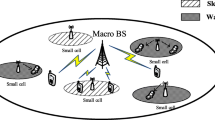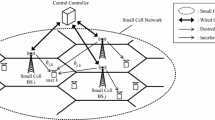Abstract
Small-cell networks (SCNs) technology is being considered as a promising solution to improve the coverage and capacity for small-cell wireless equipment (SWE). However, the deployment of SCNs is challenging due to wireless channel interference, stochastic tasks arrival, and more prominently, the long-term energy consumption constraint of SWEs. In this paper, we provide a novel distributed dynamic resource management approach for energy-aware applications in two-tier SCNs. The joint admission control (AC) at the transport layer and resource allocation (RA) at the physical layer in SWEs is proposed to solve these challenges. Specifically, the AC and RA problem under two-tier SCNs is formulated as a stochastic optimization model which aims at maximizing the long-term average throughput of SWEs in SCN subject to time-average energy consumption limitation of each SWE and network stability constraint. By adopting Lyapunov optimization theory and Lagrangian dual decomposition technique, we propose a distributed online energy-constraint throughput optimal algorithm (ETOA) to obtain optimal AC and RA decisions. Furthermore, we derive the analytical bounds for the time-average system throughput and the time-average queue backlog achieved by our proposed approach under the constraints of long-term average energy consumption and network stability. The evaluation confirms theoretical analysis on the performance of ETOA and also shows that our approach outperforms other resource allocation methods in satisfying the time-average energy consumption requirement of SWEs.








Similar content being viewed by others
References
Elsaadany M, Ali A, Hamouda W (2017) Cellular LTE-a technologies for the future internet-of-things: physical layer features and challenges. IEEE Commun Surveys Tuts 19(4):2544–2572
Ge X, Yang J, Gharavi H, Sun Y (2017) Energy efficiency challenges of 5 G small cell networks. IEEE Commun Mag 55(5):184–191
Curran M, Rahman MS, Gupta H, Zheng K, Longtin J, Das SR, Mohamed T (2017) Fsonet: a wireless backhaul for multi-gigabit picocells using steerable free space optics. In: Proceedings of the 23rd annual international conference on mobile computing and networking (MobiCom), pp 154–166
Tsiropoulou EE, Vamvakas P, Papavassiliou S (2017) Supermodular game-based distributed joint uplink power and rate allocation in two-tier femtocell networks. IEEE Trans Mobile Comput 16(9):2656–2667
Chandrasekhar V, Andrews JG, Muharemovic T, Shen Z, Gatherer A (2009) Power control in two-tier femtocell networks. IEEE Trans Wireless Com 8(8):4316–4328
Guan P, Wu D, Tian T, Zhou J, Zhang X, Gu L, Kishiyama Y (2017) 5G field trials: OFDM-based waveforms and mixed numerologies. IEEE J Sel Areas Commun 35(6):1234–1243
Chen X, Wu J, Cai Y, Zhang H, Chen T (2015) Energy-efficiency oriented traffic offloading in wireless networks: a brief survey and a learning approach for heterogeneous cellular networks. IEEE J Sel Areas Commun 33(4):627–640
Gursoy M (2007) On the capacity and energy efficiency of the training-base transmissions over fading channels. IEEE Trans Inf Theory 55(10):4543–4567
Adireddy S, Tong L, Viswanathan H (2002) Optimal placement of training for frequency-selective block-fading channels. IEEE Trans Inf Theory 48(8):2338–2353
Souza A, Amazonas J, Abrao T (2016) Power and subcarrier allocation strategies for energy-efficient uplink OFDMA systems. IEEE J Sel Areas Commun 34(12):3142–3156
Wang F, Chen W, Tang H, Wu Q (2017) Joint optimization of user association, subchannel allocation, and power allocation in multi-cell multi-association OFDMA heterogeneous networks. IEEE Trans Commun 65(6):2672–2684
Zhang H, Jiang C, Beaulieu N, Chu X, Wen X, Tao M (2014) Resource allocation in spectrum-sharing OFDMA femtocells with heterogeneous services. IEEE Trans Commun 62(7):2366– 2377
Xiang X, Lin C, Chen X, Shen X (2015) Toward optimal admission control and resource allocation for LTE-a femtocell uplink. IEEE Trans Veh Technol 64(7):3247–3261
Guo Y, Yang Q, Liu J, Kwak K (2017) Cross-layer rate control and resource allocation in spectrum-sharing OFDMA small-cell networks with delay constraints. IEEE Trans Veh Technol 66(5):4133–4147
Li Y, Sheng M, Sun Y, Shi Y (2016) Joint optimization of BS operation, user association, subcarrier assignment, and power allocation for energy-efficient HetNets. IEEE J Sel Areas Commun 34(12):3339–3353
Husso M, Hamalainen J, Jantti R, Li J, Mutafungwa E, Wichman R, Zheng Z, Wyglinski A (2010) Interference mitigation by practical transmit beamforming methods in closed femtocells. EURASIP J Wirel Commun Netw 2010(1):186815
Urgaonkar R, Neely MJ (2009) Opportunistic scheduling with reliability guarantees in cognitive radio networks. IEEE Trans Mobile Comput 8(6):766–777
Li Y, Sheng M, Shi Y, Ma X, Jiao W (2014) Energy efficiency and delay tradeoff for time-varying and TP-free wireless networks. IEEE Trans Wireless Commun 13(11):5921–5931
Sheng M, Li Y, Wang X, Li J, Shi Y (2016) Energy efficiency and delay tradeoff in device-to-device communications underlaying cellular networks. IEEE J Sel Areas Commun 34(1):92– 106
Li Y, Sheng M, Yang C, Wang X (2013) Energy efficiency and spectral efficiency tradeoff in TP-limited wireless networks. IEEE Commun Lett 17(10):1924–1927
Li Y, Sheng M, Tan C, Sun Y, Wang X, Shi Y, Li J (2015) Energy-efficient subcarrier assignment and power allocation in OFDMA systems with max-min fairness guarantees. IEEE Trans Commun 63(9):3183–3195
Ng DWK, Lo ES, Schober R (2012) Energy-efficient resource allocation in OFDMA systems with large numbers of base station antennas. IEEE Trans Wireless Commun 11(9):3292–3304
Hajisami A, Pompili D (2017) Dynamic joint processing: achieving high spectral efficiency in uplink 5 G cellular networks. Comput Netw 126:44–56
Neely MJ (2006) Energy optimal control for time varying wireless networks. IEEE Trans Inf Theory 52(7):2915–2934
Georgiadis L, Neely MJ, Tassiulas L (2006) Resource allocation and cross-layer control in wireless networks. Found Trends Netw 1(1):1–144
Neely MJ (2010) Stochastic network optimization with application to communication and queueing systems. Synthesis Lectures on Communication Networks 3(1):1–211
Bertsekas DP (2007) Dynamic programming and optimal control, 3rd ed. Athena Scientific, Belmont
Boyd S, Vandenberghe L (2004) Convex optimization. Cambridge University Press, Cambridge
Acknowledgments
This work is supported in part by the National Key Research and Development Program under Grant no. 2016YFB 1000102, in part by the National Natural Science Foundation of China under Grant no. 61672318, 61631013, and by the QUALCOMM university-sponsored program.
Author information
Authors and Affiliations
Corresponding author
Additional information
Publisher’s note
Springer Nature remains neutral with regard to jurisdictional claims in published maps and institutional affiliations.
Appendices
Appendix: A
Lemma 2
For any nonnegative real numbers x, yandz, there holds [max(x − y, 0) + z]2 ≤ x2 + y2 + z2 + 2x (z − y).
Squaring both sides of Eq. 6 and applying Lemma 2 produces
Summing over all queue backlog of SWEs at both sides of Eq. 38 and rearranging terms yield
For the update equation of Eij(t), i.e., (9), we similarly have
Rombining (39) and (40) and exploiting (11) yield
Taking conditional expectations on Eq. 41, exploiting (12), and subtracting \(\nu \mathbb {E}\left \{D(t)\left | \boldsymbol {\Psi }(t)\right .\right \}\) at both sides, we can prove (14).
Appendix: B
We then review the basic result in Theorem 1, for the proposed ETOA approach, which is given as follows
where the second inequality sign of Eq. 42 holds owing to the fact that the proposed ETOA approach minimizes the RHS of Eq. 14 over all feasible control policy Φ(t) which includes the optimal randomized stationary policy \(\mathbb {\alpha }^{*}(t)\).
Substituting (29) and (30) into (42) and using telescoping sums over all time slots in the above inequality, we obtain the following inequation as δ → 0
(a) Applying the definition of L (Ψ(t)), we can simply the inequality as follows
According to the variance formula \(D\left \{E_{ij}(t)\right \}=\mathbb {E}\left \{E_{ij}^{2}(t)\right \}-\mathbb {E}^{2}\left \{E_{ij}(t)\right \}\) and D {Eij(t)} > 0, we obtain
Dividing both sides by T and taking a lim inf as T →∞, we can obtain
Hence, virtual energy queues Eij(t) are mean rate stable based on Definition 1 and thus, the time-average energy consumption constraint C1 is satisfied according to Lemma 1. Similarly, we can prove that data queues Qij(t) are mean rate stable as well.
(b) Since the conclusion Qij(t) < Amax + ν can be proven using similar techniques as [13], we omit the detailed proof here for brevity. Considering the fact that \(\mathbb {E}\left \{L\left ({\Psi }(t)\right )\right \} \ge 0\) and Qij(t) ≥ 0, rearranging (43), we obtain the following inequality
Dividing both sides of the above inequality by νT and then taking a limit as T →∞, we can obtain
(c) Rearranging (43), we obtain
Similarly, dividing (49) by 𝜗T and then taking a limit as T →∞, we prove
Rights and permissions
About this article
Cite this article
Jiao, L., Yin, H., Guo, D. et al. Resource allocation in two-tier small-cell networks with energy consumption constraints. Peer-to-Peer Netw. Appl. 13, 1–15 (2020). https://doi.org/10.1007/s12083-018-0700-y
Received:
Accepted:
Published:
Issue Date:
DOI: https://doi.org/10.1007/s12083-018-0700-y




